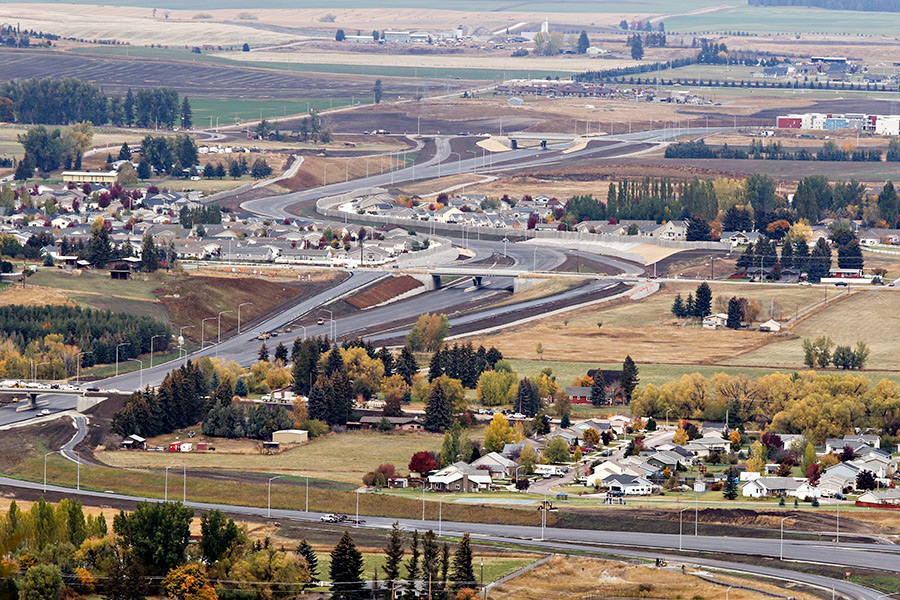Ultimately, it’s simply a road: 7.6 miles of asphalt blazing a new trail along the western outskirts of Kalispell from the southern gateway to the northern tip.
Yet it’s much more than that. The Kalispell bypass has long been one of the city’s great aspirations. Dating back to the 1940s, it represents a vision from the post-World War II boom era, when growth seemed unavoidable, and logging trucks and semi-trailers increasingly rumbled up and down the cozy two lanes of Main Street, clogging the valley’s main thoroughfare, U.S. Highway 93, with a deluge of four-lane traffic. In a wide-open state where highways are the lifeblood of communities, and in a valley isolated from the sprawling interstate system, this so-called bypass, when completed, could be both a savior and a catalyst for the historical heart of the city and the surrounding area. That much was agreed upon.
But for generations of residents who have stood through decades of waiting and wondering, who have pleaded and debated designs and redesigns of this ambitious new transportation route from one end of town to the other, who have seen Kalispell burgeon into a regional hub with one of the busiest Main Streets in Montana, and who have speculated that the bypass was nothing more than the Flathead Valley’s greatest fairytale, the perpetual question has remained: Will this road ever actually be built?
The wait is over. The bypass is built. The single largest transportation project in Montana history, roughly $140 million, is set for completion in the coming weeks, maybe even as early as Oct. 19.
LHC, the Kalispell-based construction company that was awarded a $34 million bid to complete the project over the last year, is putting the finishing touches on the four-lane, five-bridge north section of the bypass, officially called the U.S. 93 Alternate Route. A grand opening ceremony with local, state and federal leaders will be held sometime this month, with an exact date soon to be announced, but state transportation officials say the road will be ready to roll before Nov. 1.
“There’s no other project in the whole state that impacts a community and area like this one does,” said Jim Mitchell, the Montana Department of Transportation’s engineering project manager for the bypass over the last 10 years. “It totally changes the whole landscape and infrastructure of the area.”
Yes, it is simply a road, but also a historic milestone that many people thought Kalispell would never reach.
“I can’t believe it, to be honest with you,” said Doug Rauthe, a Kalispell native and former mayor and downtown businessman who is now retired. “This has been going on since I was a boy.”
“I didn’t think it would get built in my lifetime.”
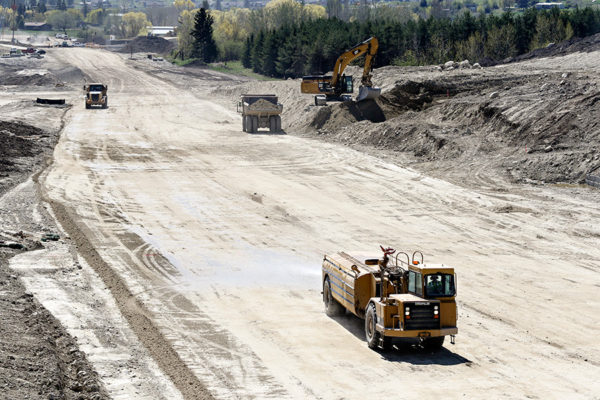
Around the same time the Allied forces were combating the Nazis and approaching victory in World War II, a communitywide discussion began in earnest in Kalispell. The town of roughly 9,000 people — the governmental seat of Flathead County and the largest community in this corner of the state — was flourishing with a strong timber industry throughout the region and attracting substantial attention as a locale for future growth, thanks in large part to the development of Hungry Horse Dam, which broke ground in 1948.
Yet only one major highway — U.S. 93 — served the greater valley from the south, funneling everyone and everything right through downtown Kalispell. The heavy industrial trucks rolling down the two-lane Main Street became a significant source of nuisance and alarm. The streets were not built to withstand these large vehicles, nor did the variety of storefronts appreciate their smoky, thundering presence.
By 1953, the situation reached a boiling point as Flathead County commissioners, as well as Kalispell city leaders and residents, pleaded to the state Highway Department for relief in the form of one or two new routes winding around Main Street.
Bad news arrived that spring in the form of a letter from Scott P. Hart, a state highway engineer.
This so-called bypass seemed unlikely at best, and was most likely a pipedream, Hart told city and county officials in a letter published in the Daily Inter Lake on Jun 11, 1953. The estimated cost to build a so-called “truck bypass” spanning 3.5 miles from U.S. 93 to U.S. 2 was $200,000, or roughly $1.8 million today after adjusting for inflation. That amount far exceeded any funds available to this region, Hart said. There were plenty of other obstacles as well, not the least of which included purchasing all of the land necessary for any future new road.
“The above explanation of the situation as a whole, which is admittedly not very encouraging, is simply that you may be in full possession of the pertinent facts,” Hart wrote. “This department recognizes the real need of by-pass facilities for Kalispell and is favorably disposed toward any practical plan which will help to solve your problem.”
The Baby Boomer generation arrived, and with it, development followed. By 1970, Kalispell’s population had grown to 10,500 while the surrounding towns similarly expanded.
On March 18, 1970, Kalispell Chief of Police Ted W. Waggener wrote a letter to the editor that appeared prominently on the second page of the Daily Inter Lake.
“For the past 15 years I have stood on Kalispell’s Main Street and watched the large diesel trucks thunder up and down the street with their heavy loads of logs towering above the traffic and the drivers pushing the speed limit to the maximum to try to hit the green lights to keep from stopping the load and having to start up through the gears to gain momentum again,” Waggener wrote.
He went on to raise safety concerns involving pedestrians, including children, and the community’s growing desire to alleviate this heavy traffic in downtown.
“At a recent meeting city officials were told by highway department officials that a truck bypass for Kalispell was at least another 20 years away,” he wrote. “I don’t think Kalispell can wait another 20 years.”
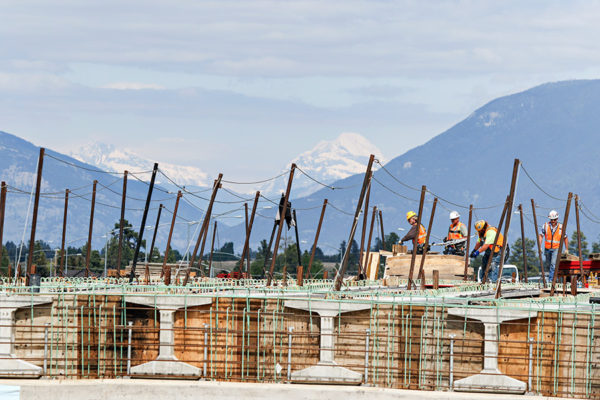
The community consensus was clear — a bypass was indeed important. But securing the funds to develop such a massive new road was proving just as challenging as ironing out the details of where it would run.
By 1983, Kalispell’s population was approaching 11,000 people. Tom Jentz was hired as a planner for the Flathead Regional Development Office, which provided joint planning services to Flathead County and its three large cities. One of the first projects he was assigned to tackle was the preliminary design standards for an alternate route around Kalispell. That same year, in response to heavy truck traffic, the state transportation agency expanded Main Street to four lanes. The change inevitably increased the flow of traffic and further galvanized downtown business owners and residents who saw Main Street transforming into a bustling expressway.
It wasn’t until the early 1990s when the real spark arrived, setting off the events leading to today, when the Montana Department of Transportation turned its attention to U.S. 93. Seeing persistent growth in Northwest Montana, the agency identified the stretch of highway from Somers to Whitefish as needing further expansion as a four-lane route.
“There was no long-term relief in sight for the downtown area, and finally the downtown business community stood up and said, ‘Enough,’” Jentz, who is now the planning director for the City of Kalispell, recalled recently.
“The downtown community really wanted the trucks off Main Street. They didn’t want the traveling public out of downtown. As the project evolved over the years, the sheer volume of traffic became so intense that it was clear we just flat out needed relief for Main Street.”
Community leaders, county officials and others rallied support locally while also bending the ear of Montana’s federal delegation.
Further analysis showed that building a bypass along Willow Glen would displace dozens of homeowners while also requiring substantial environmental remediation due to the area’s wetlands and other geographical drawbacks.
In 1993, it was finally settled: The bypass, if there ever was one, would run along the west side of Kalispell, from U.S. 93 near Four Corners to the far north end at West Reserve Drive, which was located in an area surrounded by open farmland and a lonely gravel pit.
“It was designed but at the time we didn’t have enough money to build it,” Jentz said.
With plans in place, U.S. Sen. Max Baucus successfully landed $250,000 for Kalispell to study the feasibility of the project. Momentum picked up, and more federal funding trickled in, leading MDT to start acquiring land along the proposed route. Years passed by and new property was acquired, but the community’s enthusiasm remained unrelenting.
“The stick-to-itiveness of our local leaders to go to their senators for funding kept this project alive,” Jentz said.
Persistence paid off, and just in the nick of time. By the early 2000s, the Flathead Valley was one of the fastest-growing regions in the Pacific Northwest. Kalispell’s population had spiked by nearly 10,000 people, putting the urgency of a bypass at the forefront of everyone’s minds. At the same time, the north end of Kalispell blossomed with new development, largely because of the planned bypass, according to Jentz.
“The growth up north was all predicated on that new transportation corridor,” Jentz said. “(Developers) knew it was going to be a major commercial engine.”
In 2005, Baucus and fellow Montana Sen. Conrad Burns successfully landed $6 million that could go to the bypass, which was largely designed by Kathy Harris with Stelling Engineers, now KLJ. It was far from enough to pay for the entire project, but city leaders decided to move forward in sections. The first official piece of the bypass became Old Reserve Road, a new route from U.S. 93 North connecting to Stillwater Drive. This route was seen as a benefit for many reasons, including the fact that Glacier High School was being built but only had access via Stillwater Road.
Two years later, further federal funding was secured with the help of new Montana Sen. Jon Tester, and the decision was made to develop the south portion of the bypass first as a way to guarantee that the whole project would be developed. Local and state planners made a compromise to build the south half with only two lanes instead of four and with roundabouts, which cost roughly $300,000, instead of bridges, which cost roughly $5 million, as was originally planned. By reducing the scope of the south half, it dropped the cost from roughly $45 million to $30 million.
“We never would’ve gotten the project built if we kept going for that final design,” Jentz said. “It was the best way to get this thing off the ground. That was a pivotal moment.”
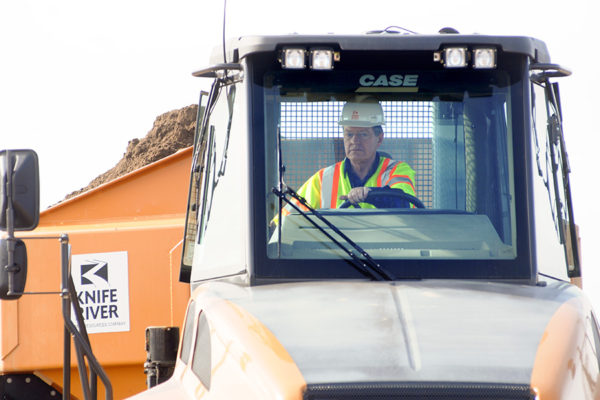
By 2010, the south portion was completed but Main Street was as busy as ever, attracting upwards of 40,000 vehicles per day. Roughly 35,000 vehicles a day traveled through the intersection of U.S. Highway 93 where Grandview and Four Mile converge near Kidsports Complex. It was among the busiest stretches of highway in Montana.
In 2013, the Kalispell Chamber of Commerce gathered signatures and sent a bus full of residents to Helena to convince the state’s transportation board to label the remaining section of bypass as a state priority. It was a success, and within two years the largest single transportation contract in Montana history — $34 million — was awarded to LHC, a local company.
LHC crews broke ground last October, building the final 3.1 miles of roadway with sound walls and five bridges. Four Mile Drive, funded through a partnership with the City of Kalispell, is also completed to Stillwater, allowing a new entrance and exit to Kidsports Complex.
“It’s a success story. It doesn’t get much better,” Jentz said. “There are so many things happening now in Kalispell because of what the bypass has done for us as a community. I questioned whether I would see it completed in my professional career.”
Now that Kalispell’s great wish has finally come to fruition, some concerns are lingering about rerouting traffic around Main Street.
“There’s some fear,” Kasee Braun, who owns Mystique Fly Shop with her husband, Tim, and father-in-law, Jim.
“There’s a little fear that traffic will be diverted away, but I think a lot of people will still pass through Kalispell.”
Others are optimistic that the bypass will help transform Main Street back to its original character as a pedestrian friendly destination and vibrant heart of the city.
“I think this will be a really positive change for downtown,” Vonnie Day, who owns Hop’s Downtown Grille, which opened on Main Street 20 years ago, with her husband, Doug. “It’s the beginning of what’s going to blossom downtown.”
Someday, when the south half is built to four lanes with interchanges, the total cost will be in the range of $160 million. There is no timeframe established for when that will happen.
Regardless, the bypass is complete, a historic milestone for Kalispell and the Flathead Valley.
Pam Carbonari, Kalispell’s former mayor and the executive director of the Kalispell Downtown Association, said, “It’s a time for our community to celebrate without a doubt.”
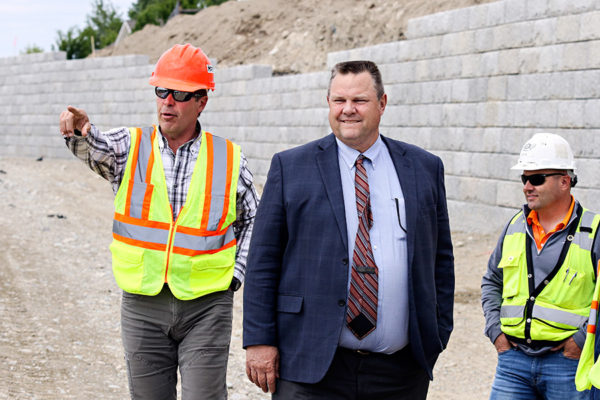
History of the Alternate Route
June 1953
Scott P. Hart, a state highway engineer, writes a letter to the city of Kalispell explaining that the chances of building a bypass road from Four Corners on U.S. Highway 93 to a connection with U.S. Highway 2 “are not very encouraging.” The Flathead County Commissioners had lobbied for the priority construction of secondary roads from south to north to eliminate truck traffic down Main Street in Kalispell. Hart says in his letter that the proposed bypass could cost an estimated $200,000, equivalent to roughly $1.8 million in today’s dollars after adjusting for inflation, far greater than the state and federal funds that are available.
July 1953
Flathead County Commissioners organize a meeting with the State Highway Department and Kalispell City Council to seek immediate action in pursuing a truck route around Kalispell. As then-Kalispell City Council President R.M. Leslie says, this is a long-discussed project dating back more than 10 years yet no action has been taken to consider building a new bypass. Leslie delivers a letter to state officials explaining the traffic problems and “immediate dangers resulting from heavy truck traffic through Kalispell.”
Jan. 1, 1967
In a guest editorial published in the Daily Inter Lake, Kalispell Mayor Thomas Flynn predicts that a new bypass for heavy truck traffic will be built by 1975.
1972
At a public meeting hosted by the Kalispell City Council, residents debate whether the future bypass should be routed on the east side or west side of town. An initial proposal was to build a new highway along Willow Glen, which drew opposition from residents in that neighborhood, or a new route along the Burlington Northern rail on the west side, which drew similar neighborhood opposition. There is, however, consensus among residents that a bypass is necessary, despite concerns voiced by Kalispell councilor Forrest Daley that a bypass “might injure the downtown area economically,” according to a story published in the Daily Inter Lake on May 11.
1992
The Montana Department of Transportation proposes a large redevelopment of U.S. Highway 93 from Somers to Whitefish, including expanding the highway throughout Kalispell. The proposal draws local opposition and reinvigorates the long-discussed bypass. A local advisory committee is formed to explore options for Kalispell.
October 1993
With the urging of the city council and downtown businesses, the Kalispell Transportation Plan and Bypass Feasibility Study issues a recommendation to build a west-side bypass around Kalispell. The recommendation comes after planners studied the east-side route, which would displace several residents along Willow Glen while also facing environmental challenges, such as water issues along the route.
1994
The state highway department approves the western bypass.
1996
The Department of Transportation begins designing the bypass alignment but does not identify it as a priority project for funding.
1997
Properties along the proposed bypass route begin to be purchased using funds earmarked by U.S. Sen. Max Baucus, who secured a 60 percent increase in Montana’s share of highway dollars, leading to $1.2 billion in new investment across the state.
2004
MDT re-evaluates the Kalispell bypass and begins preliminary design. The bypass is estimated to cost $28 million and would route from U.S. 93 south of town, crossing U.S. 2 west of Kalispell and rejoining U.S. 93 from West Reserve Drive north of town. The agency holds a kickoff meeting with residents to familiarize them with the project.
2007
MDT funds construction of Reserve Loop, a 1.2-mile stretch of road that connects U.S. 93 around the newly developed Glacier High School to Stillwater Road. The project is technically the first portion of the bypass and includes the area’s first modern roundabout at Stillwater.
2008
Unable to fund construction of the entire bypass, MDT compromises and decides to fund the development of a pared-down south portion, which goes from four lanes with bridges to two lanes and roundabouts.
Fall 2010
The south portion of bypass from U.S. 93 South to U.S. 2 South is completed at a cost of $34 million using funds that were secured by Montana’s Congressional delegation, including U.S. Sen. Jon Tester.
2012
The Hutton Ranch road extension is completed, providing a two-lane roadway with a roundabout off East Reserve. Two new signals are installed on West Reserve Drive and on Hutton Ranch Road.
2013
The segment of Reserve Loop to U.S. 93 is completed with four-lane roads and a separated bike path along the bypass and Old Reserve Drive.
2014
The Three Mile Drive reconstruction is completed with a new bridge over the future north section of bypass.
Oct. 12, 2015
LHC, a Kalispell-based contractor, breaks ground on the final phase of the bypass. “Today we are participants and witnesses to one of those defining moments in time that will be one of the most transformational events for our community since the railroad gave birth to our town in 1892,” Kalispell Mayor Mark Johnson tells a crowd gathered at a groundbreaking ceremony. Over $100 million had already been poured into the project, and the final contract, awarded to LHC at nearly $34 million, was the largest single transportation contract in the state’s history. The agency combined the final three phases of construction into one contract to expedite construction, and in the process saved an estimated $9 million, according to state transportation officials.
Fall 2016
The north section is finished, marking the completion of the entire bypass, which is the largest single transportation project in Montana history.
